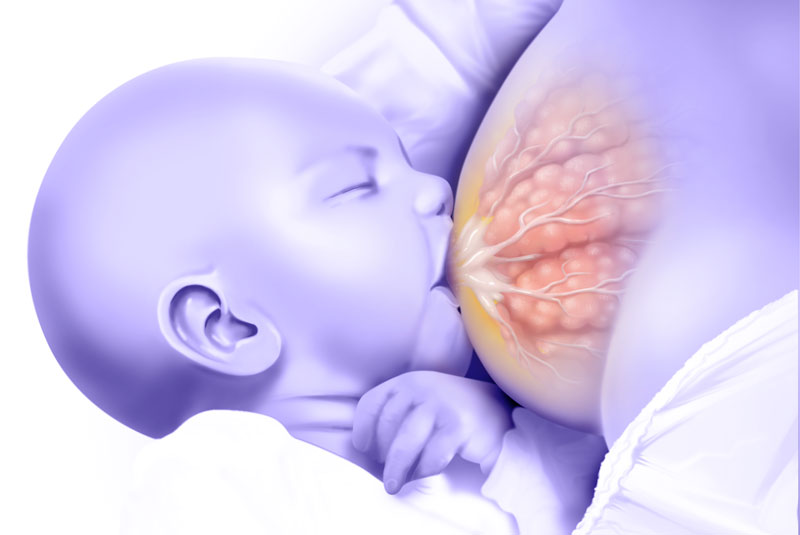To ward off fatty liver, breast is best for mom

Study finds fatty liver disease is less likely to occur in mothers who breastfeed for more than six months.
Researchers at UC San Diego School of Medicine and Kaiser Permanente have discovered that mothers who breastfed a child or children for six months or more are at lower risk for developing non-alcoholic fatty liver disease (NAFLD) years later during mid-life. With no other current prevention options aside from a healthy lifestyle, they say the finding may represent an early modifiable risk factor for a serious and chronic disease.
The findings are published in the November 1, 2018 issue of the Journal of Hepatology.
“Breastfeeding and its benefits to the child have been widely studied for years,” said Veeral Ajmera, MD, hepatologist and assistant professor of medicine at UC San Diego Health. “However, this new analysis contributes to the growing body of evidence showing that breastfeeding a child also offers significant health benefits to the mother—namely, protecting her from developing non-alcoholic fatty liver disease in middle age.”
Ajmera and colleagues used data collected through the Coronary Artery Risk Development in Young Adults (CARDIA) study – a multicenter prospective cohort study of 844 black and white women who were monitored every two to five years for up to 30 years. The women were assessed for biochemical and other risk factors at enrollment in 1985-1986. Those who subsequently gave birth reported the duration of breastfeeding for each birth over the following 25 years. At the end of the study, participants underwent a computed tomography (CT) scan of their abdomens, which allowed researchers to look at levels of liver fat, a sign of NALFD.
“The CARDIA study’s unique strength is the evaluation of cardiovascular and metabolic risk factors in young women before pregnancy and across the childbearing years,” said senior author Erica P. Gunderson, PhD, MS, MPH, a senior research scientist with the Kaiser Permanente Northern California Division of Research and investigator at the Oakland, Calif., CARDIA field site. “This design accounts for pre-pregnancy risk factors and identifies more closely the specific relation of lactation to a woman’s future disease risk.”
According to study findings, women in the cohort who breastfed one or more children for longer than six months had a lower risk of NAFLD compared to those who did not breastfeed or breastfed for under one month. Typical of NAFLD, women diagnosed with the disease 25 years later had a higher body mass index, larger waist circumference, higher triglycerides and lower HDL cholesterol when compared to those without NAFLD.
NAFLD remains the most common cause of chronic liver disease in the United States. It is usually asymptomatic until advanced stages of liver disease and includes a spectrum of disease severity, with nonalcoholic steatohepatitis (NASH) being the most aggressive type. Multiple genetic and environmental factors contribute to NAFLD, and certain health conditions, such as obesity and type 2 diabetes, can be predisposing factors. It is estimated that tens of millions of people globally are living with NAFLD and NASH. Weight loss and a healthier diet are the current standards of care.
Because these diseases are linked with obesity, diabetes, insulin resistance and lifestyle behaviors, Ajmera and team adjusted for these pre-pregnancy metabolic risk factors, physical activity and dietary intake. The analysis helped demonstrate that any beneficial impact of lactation duration goes beyond confounding factors of pre-pregnancy risk and lifestyle behaviors.
“Non-alcoholic fatty liver disease and all metabolic diseases have a unique relationship with socioeconomic factors,” said Ajmera. “The inclusion of additional information regarding diet and exercise only further strengthen our claim that breastfeeding is beneficial in the prevention of non-alcoholic fatty liver disease.”
Ajmera said more studies are needed to look at the underlying mechanisms of how lactation affects NAFLD and whether it can reduce disease severity.
Co-authors include Norah A. Terrault and Monika Sarkar, UC San Francisco; Lisa B. VanWagner, Northwestern University; Cora E. Lewis, University of Alabama Birmingham; and John J. Carr, Vanderbilt University.
Full study: 10.1016/j.jhep.2018.09.013
Media contact
Gabrielle Johnston, MPH, 858-249-0428, gnjohnston@ucsd.edu or Scott LaFee, slafee@ucsd.edu, 858-249-0428

